Wieliczka and Bochnia Royal Salt Mines: The Wieliczka Salt Mine is one of the oldest mines in the world. The mine has been worked as a source of rock salt since 1044. The Wieliczka Salt Mine is the only salt mine in the world functioning continuously since the Middle Ages. The mine consist of nine levels, reaching a depth of 327 m. The total length of the Wieliczka Salt Mine galleries is about 300 km, connecting more than 2000 excavation chambers. Artists and miners have left behind salt carvings and chapels cut out of the salt. The Chapel of St. Kinga is the most beautiful underground chapel of the Wieliczka Salt Mine. Tourists have been visiting the mine since the 15th century. The mine has been visited by famous people such as Copernicus, Baden-Powell, Goethe, Bill Clinton, Frédéric Chopin and Pope John Paul II. Visitors come down the staircase in the Danilowicz Shaft into salt mine, descending 378 steps. The guided walk includes visits to several chambers, connected by 2.5 km of corridors, the last stop of the visit is an underground souvenir shop and the post office. From here the original elevator will bring visitors up to the ground level. The Wieliczka Salt Mine is situated close to Kraków in the Małopolska region of Poland. The Wieliczka Salt Mine was declared a UNESCO World Heritage in 1978. The Wieliczka Salt Mine is also one of the Seven Wonders of Poland. The Bochnia Royal Salt Mine became a UNESCO World Heritage in 2013. The Bochnia Salt Mine is the oldest salt mine in Poland. The salt mines are inscribed on the UNESCO World Heritage List as: Wieliczka and Bochnia Royal Salt Mines. World Heritage Art: Corridors of Salt
www.werelderfgoedfotos.nl © Copyright World Heritage Photos
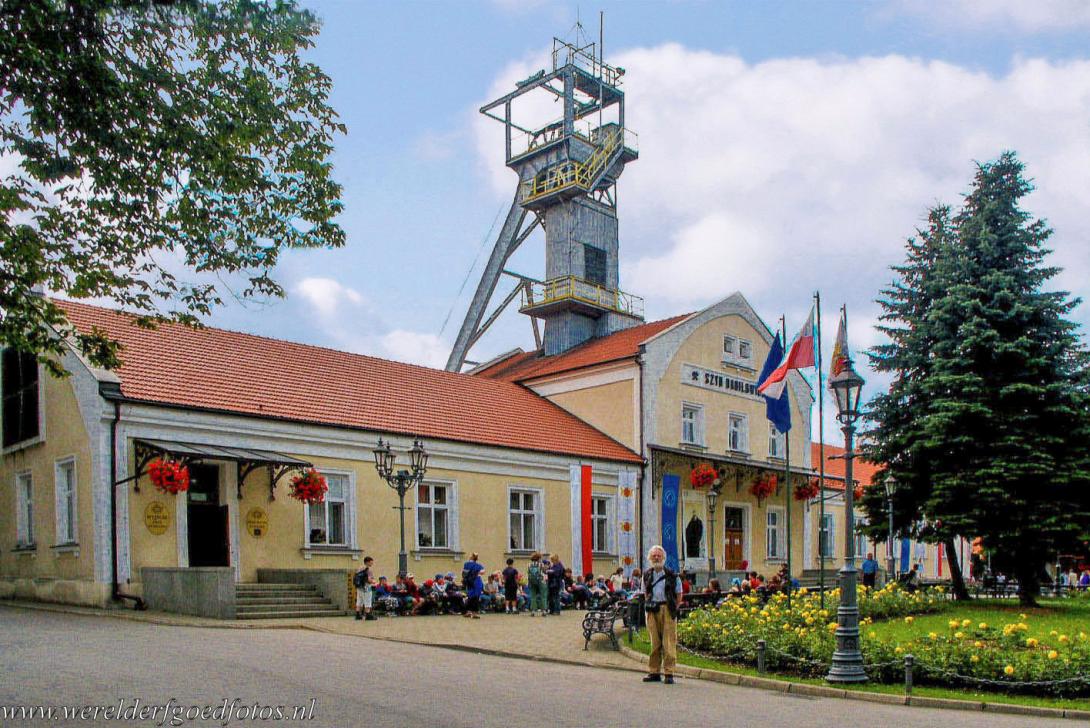
The main building and the Danilowicz Shaft of the Wieliczka Salt Mine, situated near Kraków in southern Poland. The Wieliczka Salt Mine is, together with the neighbouring Bochnia Royal Salt Mine, one of the oldest salt mines in the world. The Wieliczka Salt Mine has been worked as a source of rock salt since 1044. The Bochnia Royal Salt Mine is considered the oldest salt mine in Poland. The Wieliczka and Bochnia Royal Salt Mines were declared a UNESCO World Heritage.

The main building and the Danilowicz Shaft of the Wieliczka Salt Mine, situated near Kraków in southern Poland. The Wieliczka Salt Mine is, together with the neighbouring Bochnia Royal Salt Mine, one of the oldest salt mines in the world. The Wieliczka Salt Mine has been worked as a source of rock salt since 1044. The Bochnia Royal Salt Mine is considered the oldest salt mine in Poland. The Wieliczka and Bochnia Royal Salt Mines were declared a UNESCO World Heritage.
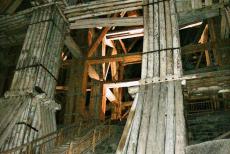
Wieliczka Salt Mine: The impressive wooden staircase in the Danilowicz Shaft is leading into the Michalowice Chamber. The total length of the Wieliczka Salt Mine galleries is some 300 km, they connect more than 2000 excavation chambers. The Danilowicz shaft connects the surface and level VI, 104 metres underground. Visitors come down the staircase in the Danilowicz Shaft into the mine, descending 378 steps. The tour starts at the bottom of the shaft and takes two hours.
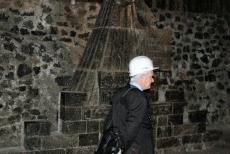
Wieliczka Salt Mine: A guide in the Mikolaj Kopernik Chamber. The Mikolaj Kopernik Chamber is named after the Polish astronomer Nicolaus Copernicus, he was one of the first visitors of the Wieliczka Salt Mine. Numerous tourists have been visiting the Wieliczka Salt Mine since the 15th century. Important visitors were, for instance, Robert Baden-Powell, Bill Clinton, Goethe, Pope John Paul II and the Polish composer and pianist Frédéric Chopin.
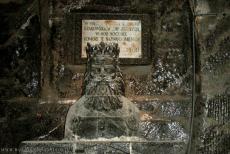
Wieliczka Salt Mine: A salt bust of the Polish King Kazimierz the Great in the King Kazimierz the Great Chamber. The king organized mining law in the late 14th century. During the guided tour, visitors can view ancient mine chambers, chapels, many sculptures, everything made of salt. The temperature down the mine is about 15 °C, warm clothes and sturdy shoes are recommended. The Wieliczka Salt Mine is one of the largest tourist attractions of Poland.
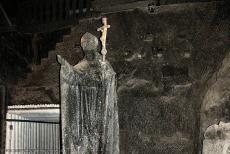
Wieliczka Salt Mine: The statue of the Polish-born Pope John Paul II was created in 1999 and is also carved out of salt. The mine has been visited by the Pope John Paul II. The salt mine is often referred to as the 'Underground Salt Cathedral of Poland'. Pope John Paul II, born Karol Wojtyla, visited the salt mine three times, two times as a student and the third time as a cardinal. He was born in Wadowice, a small town situated about 55 km from the town of Wieliczka.
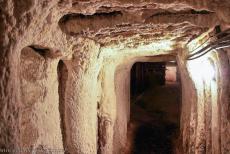
Wieliczka Salt Mine: The guided tour consists of several chambers joined by 2.5 km of corridors of salt. The Wieliczka Salt Mine is the only salt mine in the world functioning continuously since the medieval period. The original salt excavations are situated on nine levels. The Wieliczka Salt Mine was closed in 1996. Now, the Wieliczka Salt Mine has an underground treatment centre for diseases such as asthma and skin diseases.
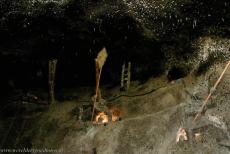
Wieliczka and Bochnia Royal Salt Mines: The Spalone Chamber (Burned Out Chamber) contains several salt statues, commemorating the miners whose job it was to burn out the mine gas that would accumulate at the ceilings of the chambers and corridors of the salt mines. The miners had to crawl into small spaces with a torch and burn out the mine gas. The gas was burned out by experienced miners. This was extremely dangerous work, it was rewarded with extra salt.
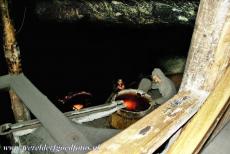
Wieliczka Salt Mine: Ancient mining in the Pieskowa Skala Chamber. The Pieskowa Skala is one of the most attractive chambers in the Wieliczka Salt Mine, an ancient stairway used by the salt bearers was carved into the rock salt. The Wieliczka Salt Mine is the only location in the world where salt mining has continued since medieval times. Horses also worked underground in the salt mine. Some horses lived their entire life inside the mine without ever seeing the light of day.
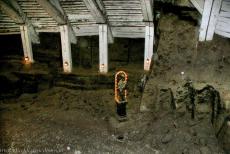
Wieliczka Salt Mine: A small monument of salt in the Jozef Pilsudski Chamber depicts St. John of Nepomuk, the patron saint of Bohemia and the protector from drowning and floods. One of the underground salt lakes is situated in the Jozef Pilsudski Chamber. Despite the presence of the saint, there were several drownings in this chamber. During WWII, when Poland was occupied by Nazi Germany, several drunk German soldiers drowned in the underground salt lake.
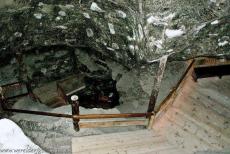
Wieliczka Salt Mine: A 136 metres deep mine shaft. During WWII, when Poland was occupied by the Nazi regime, the Wieliczka Salt Mine was used by the Nazis for manufacturing aircraft parts, the mine consist of nine levels, reaching a depth of 327 metres, safe for Allied bombers. Today, only a small part of the Wieliczka Salt Mine is open to visitors. The Wieliczka Salt Mine situated in the small town of Wieliczka in the Małopolska region in southern Poland.
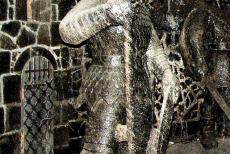
Wieliczka Salt Mine: A statue of salt in the Janowice Chamber. The statues of salt in the Janowice Chamber illustrate one of the oldest legends of the Wieliczka Salt Mine, the discovery of the rock salt. The Wieliczka miners have left behind many salt carvings. There are numerous works of art, altars, reliefs, statues and even several chapels carved out of the rock salt. The rock salt occurs naturally in different shades of grey.
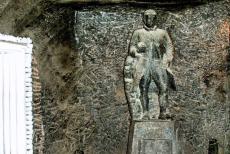
Wieliczka Salt Mine: The salt statue of Goethe. Over the years, miners sculpted sacred, mythical and historical figures of salt to decorate the chapels and chambers in the salt mine. There are numerous statues of prominent people who visited the mine. The Cracow Saltworks was one of the first companies in Europe, it was established in the 13th century and managed the Wieliczka Salt Mine and Bochnia Salt Mine.
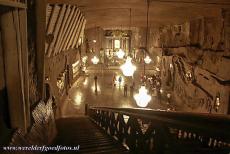
The Chapel of St. Kinga is the most beautiful chapel of the Wieliczka Salt Mine, it lies more than 100 metres below the surface, is 54 metres long and carved entirely out of salt, even the floor tiles, chandeliers and staircase are made of salt. The capel has been a place of worship since 1896. Miners were always very religious, because they were working underground in darkness and constant danger. As they excavated the salt, miners created underground chapels to pray.
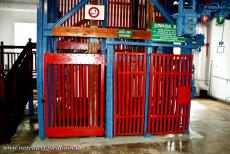
Wieliczka Salt Mine: After the guided tour, the original elevator will bring visitors up to ground level. For safety reasons, only a small part of the salt mine is open to visitors, still almost three km in length. The Wieliczka Salt Mine became a UNESCO World Heritage in 1978. The Bochnia Salt Mine was an extension to the Wieliczka Salt Mine in 2013. The salt mines were inscribed on the UNESCO World Heritage List as: Wieliczka and Bochnia Royal Salt Mines.
